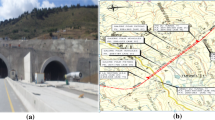Abstract
To investigate interaction problems between tunnel and existing shallow foundation, 2D model tests and the corresponding numerical simulations were carried out. For the model tests, a new tunnel apparatus to simulate tunnel excavation was developed, where the vertical and horizontal movement of the tunnel itself is allowed with satisfying the equilibrium between tunnel and the surrounding ground. The corresponding finite element analyses were conducted using FEMtij-2D software where elastoplastic model named the Subloading tij model is used as a constitutive model of soil. It is shown from model tests and numerical simulations that real movement of tunnel during excavation process is in between the conditions of fixed centre and fixed invert, though it is close to the condition of fixed invert in shallow tunnelling. The earth pressure distribution around the tunnel depends on the movement of tunnel itself as well as the inner displacement of the tunnel. The surface settlement trough is also very much influenced by the tunnel movement even if the inner displacement of tunnel is the same. In the influence of tunnelling on existing shallow foundation, the shear band in the ground develops toward the both edges of foundation. It follows that the maximum surface settlement occurs not above the tunnel but at the position of foundation, when the foundation exists near the tunnel. Unsymmetrical earth pressure distribution is seen around the tunnel near the existing foundation.













Similar content being viewed by others
References
Boscardin MD, Cording EJ (1989) Building response to excavation induced settlement. J Geotech Eng ASCE 115(1):1–21
Burd HJ, Houlsby GT, Augarde CE, Liu G (2000) Modelling the effects on masonry buildings of tunnelling-induced settlement. ICE Proc Geotech Eng. 143(1):17–29
Franzius JN, Potts DM, Addenbrooke TI, Burland JB (2004) The Influence of building weight on tunneling-induced ground and building deformation. Soils Found 44(1):25–38
Jacobsz SW, Standing JR, Mair RJ, Hagiwara T, Sugitama T (2004) Centrifuge modeling of tunneling near driven piles. Soils Found 44(1):49–56
Loganathan N, Poulos HG, Xu KJ (2001) Ground and pile-group response due to tunnelling. Soils Found 41(1):57–67
Shahin HM, Nakai T, Zhang F, Kikumoto M, Nakahara E (2011) Behavior of ground and response of existing foundation due to tunnelling. Soils Found 51(3):395–409
Shahin HM, Nakai T, Ishii K, Iwata T, Kuroi S (2016) Invetigation of influence of tunneling on existing building and tunnel—model tests and numerical simulations. Acta Geotechnicla 11(3):679–692
Nakai T, Hinokio M (2004) A simple elastoplastic model for normally and over consolidated soils with unified material parameters. Soils Found 44(2):53–70
Nakai T (2012) Constitutive modeling of geomaterials: principles and applications. CRC Press, Boca Raton
Adrain RJ (1991) Particle imaging techniques for experimental fluid mechanics. Ann Rev Fluid Mech 23:261–304
Nakai T, Mihara Y (1984) A new mechanical quantity for soils and its application to elastoplastic constitutive models. Soils Found 24(2):82–94
Hashiguchi K (1980) Constitutive equation of elastoplastic materials with elasto- plastic transition. J Appl Mech ASME 102(2):266–272
Nakai T, Farias MM, Bastos D, Sato Y (2007) Simulation of conventional and inverted braced excavation using subloading tij model. Soils Found 47(3):597–612
Nakai T, Shahin HM, Zhang F, Hinokio M, Kikumoto M, Yonaha S, Nishio A (2010) Bearing capacity of reinforced foundation subjected to pull-out loading in 2D and 3D conditions. Geotext Geomembr 28(3):268–280
Funding
Not applicable.
Author information
Authors and Affiliations
Corresponding author
Rights and permissions
About this article
Cite this article
Shahin, H.M., Nakai, T., Ishii, K. et al. Experimental and Numerical Investigation of Fundamental Mechanism of Tunnelling and Influence on Nearby Flat Foundation. Int J Civ Eng 17, 91–101 (2019). https://doi.org/10.1007/s40999-018-0338-4
Received:
Revised:
Accepted:
Published:
Issue Date:
DOI: https://doi.org/10.1007/s40999-018-0338-4




